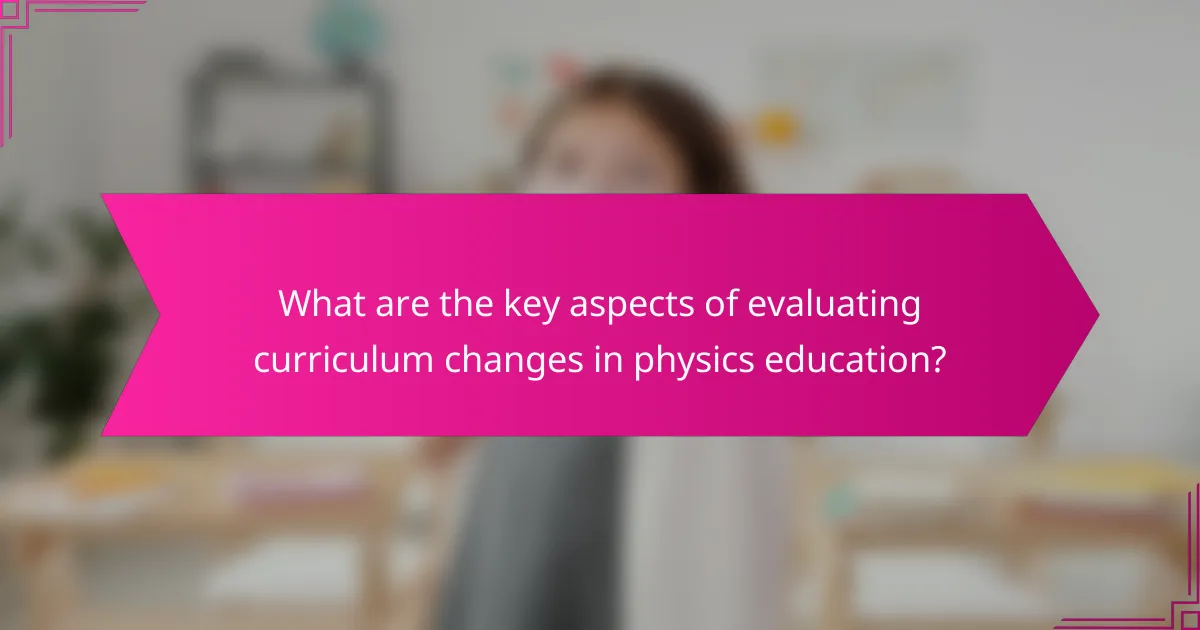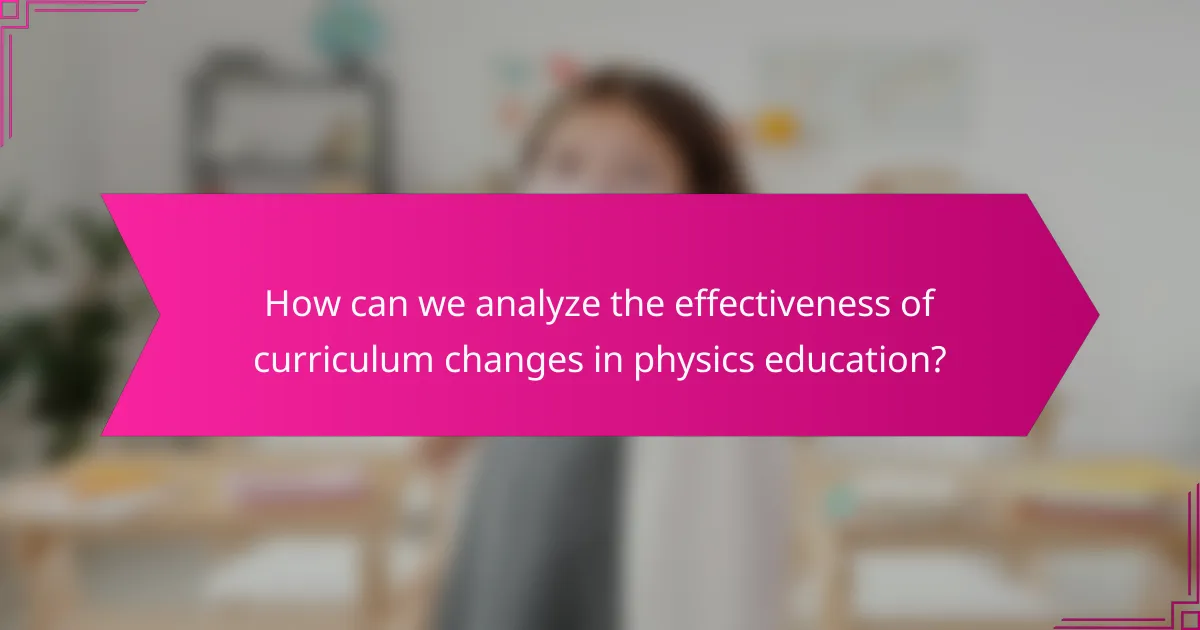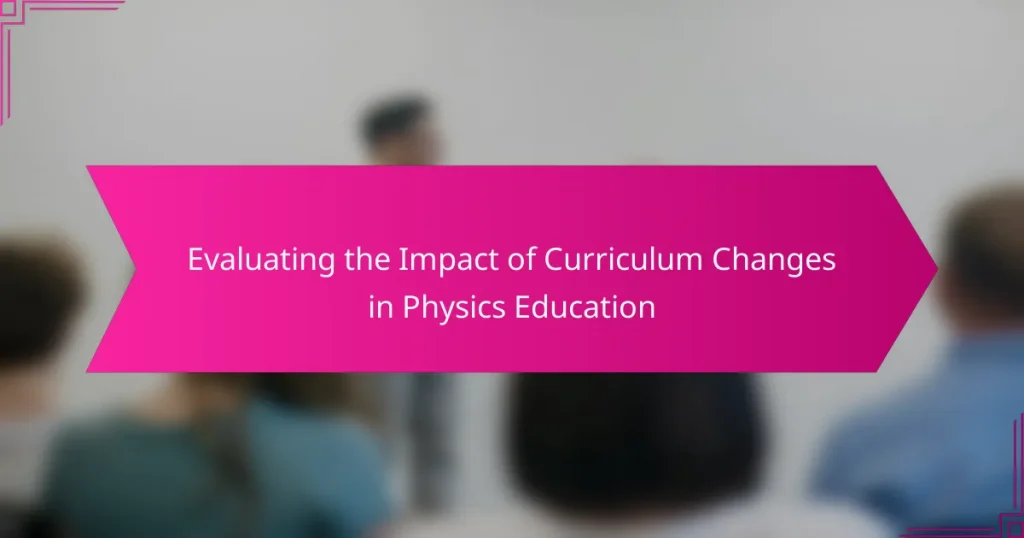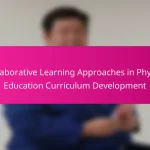Evaluating curriculum changes in physics education involves assessing student learning outcomes, analyzing instructional methods, and gathering feedback from stakeholders. Key methods for evaluation include pre- and post-tests to measure knowledge retention, surveys for student feedback, and observations of classroom engagement. Additionally, standardized test scores and longitudinal studies provide insights into overall academic performance and student progress over time. Research emphasizes that comprehensive evaluations, including mixed-method approaches, lead to improved educational practices and enhanced student performance in physics, ensuring alignment with educational standards.

What are the key aspects of evaluating curriculum changes in physics education?
Key aspects of evaluating curriculum changes in physics education include assessing student learning outcomes, analyzing instructional methods, and gathering stakeholder feedback. Evaluating student learning outcomes involves measuring knowledge retention and conceptual understanding through assessments. Instructional methods should be analyzed for their effectiveness in engaging students and facilitating learning. Gathering feedback from students, teachers, and administrators provides insights into the curriculum’s relevance and applicability. Additionally, examining alignment with educational standards ensures that curriculum changes meet required benchmarks. Research indicates that comprehensive evaluations lead to improved educational practices and better student performance in physics.
How do curriculum changes impact student learning outcomes?
Curriculum changes significantly impact student learning outcomes. These changes can enhance engagement and understanding of physics concepts. For instance, incorporating inquiry-based learning has been shown to improve critical thinking skills. A study by the National Research Council found that students in reformed curricula scored higher on assessments than those in traditional settings. Additionally, updated curricula that integrate technology can foster better collaboration among students. Research indicates that students using interactive simulations demonstrate improved problem-solving abilities. Therefore, effective curriculum changes can lead to measurable improvements in student performance and comprehension in physics education.
What metrics are used to assess student performance in physics?
Metrics used to assess student performance in physics include standardized test scores, lab performance, and homework assignments. Standardized tests measure students’ understanding of physics concepts and problem-solving skills. Lab performance evaluates practical skills and the application of theoretical knowledge. Homework assignments assess students’ grasp of course material and their ability to apply concepts independently. Additionally, formative assessments like quizzes provide ongoing feedback. Peer evaluations and self-assessments also contribute to a comprehensive picture of student performance in physics. These metrics collectively help educators identify areas for improvement and inform curriculum adjustments.
How can we measure student engagement and interest in physics?
Student engagement and interest in physics can be measured through various methods. Surveys and questionnaires can assess students’ attitudes towards physics. Observations during class can provide insights into student participation and enthusiasm. Standardized tests can evaluate students’ understanding and interest levels. Additionally, analyzing students’ performance in physics-related projects can indicate their engagement. Research shows that active learning strategies significantly enhance student interest in STEM subjects. A study by Freeman et al. (2014) found that active learning increases student performance in STEM courses by 6%.
What are the common types of curriculum changes in physics education?
Common types of curriculum changes in physics education include content updates, pedagogical shifts, and assessment modifications. Content updates involve integrating new scientific discoveries and technologies into the curriculum. Pedagogical shifts focus on adopting inquiry-based or student-centered learning approaches. Assessment modifications may include implementing formative assessments to gauge student understanding regularly. Research shows that these changes aim to enhance student engagement and learning outcomes. For instance, the American Association of Physics Teachers advocates for active learning strategies to improve student performance in physics courses.
What role do technology and digital resources play in curriculum updates?
Technology and digital resources significantly enhance curriculum updates by facilitating access to current information and diverse learning materials. They allow educators to integrate interactive and multimedia content, making lessons more engaging. Digital tools enable real-time data analysis and simulations, particularly beneficial in physics education. For instance, platforms like PhET Interactive Simulations provide virtual labs that enhance understanding of complex concepts. Additionally, technology supports personalized learning, allowing students to progress at their own pace. Research indicates that schools using digital resources see improved student outcomes, particularly in STEM subjects. Therefore, technology and digital resources are crucial in modernizing and enriching curriculum updates.
How do interdisciplinary approaches influence physics curriculum design?
Interdisciplinary approaches significantly influence physics curriculum design by integrating concepts from various fields. This integration enhances students’ understanding of physics through real-world applications. For example, combining physics with biology can clarify concepts like biomechanics. Such collaborations foster critical thinking and problem-solving skills. Research indicates that interdisciplinary curricula improve student engagement and retention. A study by Beers (2011) found that students in interdisciplinary programs scored higher in science assessments. This evidence supports the effectiveness of interdisciplinary approaches in enriching physics education.
What challenges arise when implementing curriculum changes in physics education?
Implementing curriculum changes in physics education presents several challenges. Resistance from educators often occurs due to established teaching methods. Teachers may feel unprepared to adapt to new content or pedagogical approaches. Limited resources can hinder the implementation of innovative teaching strategies. Additionally, aligning curriculum changes with standardized testing requirements poses a significant obstacle.
Student engagement may also decline if the new curriculum does not resonate with their interests. Professional development opportunities for teachers are frequently inadequate, leaving them without necessary support. Furthermore, varying levels of student preparedness can complicate the introduction of new concepts. These challenges collectively impact the effectiveness of curriculum changes in physics education.
How do teacher training and professional development affect curriculum effectiveness?
Teacher training and professional development significantly enhance curriculum effectiveness. Effective training equips educators with the necessary skills and knowledge to deliver content effectively. Research shows that teachers who engage in ongoing professional development improve their instructional practices. For instance, a study by Darling-Hammond et al. (2017) found that high-quality professional development can lead to increased student achievement. Furthermore, trained teachers are more likely to implement curriculum changes effectively, adapting them to meet diverse student needs. This adaptability contributes to a more engaging and relevant learning environment. Overall, teacher training and professional development are crucial for maximizing the impact of curriculum changes in physics education.
What resistance might educators face during curriculum implementation?
Educators might face resistance during curriculum implementation due to various factors. One significant factor is a lack of training on new curriculum content. Educators may feel unprepared to teach new material effectively. Additionally, existing workloads can create resistance. Many educators already manage extensive responsibilities, making it challenging to adopt new practices.
Resistance can also stem from differing opinions among educators about the curriculum’s relevance. Some educators may believe that the changes do not align with their teaching philosophy. Furthermore, student and parent pushback can occur if they are not adequately informed about the changes. This can lead to a lack of support for the new curriculum.
Finally, systemic issues within the educational institution can contribute to resistance. Limited resources and administrative support can hinder the successful implementation of new curricula. These factors collectively create challenges for educators trying to adapt to curriculum changes in physics education.

How can we analyze the effectiveness of curriculum changes in physics education?
To analyze the effectiveness of curriculum changes in physics education, we can use various assessment methods. These methods include pre- and post-tests to measure student understanding. Surveys can gather student feedback on the curriculum. Observations of classroom engagement provide qualitative data on teaching effectiveness. Standardized test scores can indicate overall academic performance. Additionally, longitudinal studies track student progress over time. Research shows that these approaches can yield comprehensive insights into educational outcomes. For example, a study by the National Science Foundation highlights the importance of mixed-method evaluations in understanding curriculum impact.
What research methodologies are best suited for evaluating curriculum changes?
Qualitative and quantitative research methodologies are best suited for evaluating curriculum changes. Qualitative methods include interviews, focus groups, and observations. These methods provide in-depth insights into student and teacher experiences. Quantitative methods involve surveys and standardized assessments. These methods offer measurable data on student performance and engagement. Mixed-methods approaches combine both qualitative and quantitative data. This approach provides a comprehensive understanding of curriculum impact. Research by Hattie (2009) emphasizes the importance of using multiple methodologies for effective evaluation.
How can qualitative data enhance our understanding of curriculum impact?
Qualitative data can enhance our understanding of curriculum impact by providing in-depth insights into student experiences. It captures the nuances of how students engage with learning materials. This data can reveal students’ perceptions, motivations, and challenges. For instance, interviews and focus groups can uncover specific areas where the curriculum succeeds or falls short. Research shows that qualitative feedback often highlights aspects that quantitative data may overlook. A study by Merriam and Tisdell (2015) emphasizes the importance of qualitative methods in educational evaluation. Their findings indicate that qualitative data can lead to more informed decisions about curriculum improvements.
What role does quantitative analysis play in curriculum evaluation?
Quantitative analysis plays a crucial role in curriculum evaluation by providing measurable data to assess educational effectiveness. It enables educators to analyze student performance, engagement, and retention through statistical methods. For instance, standardized test scores can reveal the impact of curriculum changes on student learning outcomes. Additionally, surveys can quantify student satisfaction and perceived relevance of the curriculum. Research indicates that using quantitative metrics leads to more objective evaluations. A study by McKinsey & Company found that schools employing data-driven approaches improved student performance by 20%. Thus, quantitative analysis is essential for informed decision-making in curriculum development.
What are the long-term effects of curriculum changes on physics education?
Long-term effects of curriculum changes on physics education include improved student engagement, enhanced conceptual understanding, and better retention of knowledge. These changes often lead to the integration of modern teaching methods and technology in the classroom. Research indicates that updated curricula can result in higher student achievement scores. For example, studies show that inquiry-based learning approaches significantly improve students’ problem-solving skills. Additionally, curriculum changes can foster a more inclusive learning environment, accommodating diverse learning styles. Over time, these factors contribute to a more scientifically literate society.
How do curriculum changes influence students’ career paths in STEM fields?
Curriculum changes significantly influence students’ career paths in STEM fields. Updated curricula often incorporate current technologies and methodologies. This alignment with industry standards prepares students for relevant job markets. Research indicates that students exposed to modern STEM curricula are more likely to pursue related careers. For example, a study by the National Science Foundation found that hands-on learning experiences increase student interest in STEM professions. Additionally, curriculum changes that emphasize problem-solving skills enhance employability. Consequently, students are better equipped to meet the demands of evolving STEM industries.
What lasting impacts do curriculum changes have on educational institutions?
Curriculum changes have significant lasting impacts on educational institutions. They can lead to improved student engagement and performance. Research shows that updated curricula often align better with contemporary educational standards and societal needs. For example, the integration of technology in physics education has enhanced interactive learning, resulting in higher retention rates. Changes can also affect teacher training and professional development requirements. Institutions may need to invest in resources and training to implement new curricula effectively. Additionally, curriculum changes can influence institutional reputation and student enrollment. Schools that adapt to modern educational trends often attract more students. Overall, curriculum changes reshape educational practices and outcomes within institutions.
What best practices can be adopted for successful curriculum evaluation in physics education?
Successful curriculum evaluation in physics education involves systematic assessment and data-driven decision-making. First, align evaluation criteria with educational standards and learning objectives. This ensures that the curriculum meets established educational goals. Next, gather diverse data sources, including student assessments, surveys, and observational studies. This approach provides a comprehensive view of curriculum effectiveness.
Incorporate both qualitative and quantitative methods to analyze data. Qualitative feedback from students and teachers can reveal insights that numbers alone may miss. Regularly review and update evaluation processes to reflect changes in educational practices and technologies. This adaptability is crucial for maintaining relevance.
Engage stakeholders, including educators, students, and parents, in the evaluation process. Their input can enhance the curriculum and address specific needs. Finally, implement a feedback loop to continuously refine the curriculum based on evaluation findings. This iterative process promotes ongoing improvement and better learning outcomes in physics education.
How can feedback from students and educators inform future curriculum decisions?
Feedback from students and educators can significantly shape future curriculum decisions. It provides insights into the effectiveness of teaching methods and content delivery. Student feedback highlights areas where they struggle or excel. Educator feedback offers professional perspectives on curriculum alignment with educational standards. Together, this information helps identify gaps in knowledge and skills. For instance, surveys and focus groups can reveal common challenges faced by students. This data can lead to targeted improvements in lesson plans. Research shows that responsive curriculum adjustments can enhance student engagement and learning outcomes. Therefore, integrating feedback is essential for continuous curriculum development.
What strategies can be employed to ensure continuous improvement in physics education?
Continuous improvement in physics education can be achieved through several strategies. Implementing regular curriculum reviews ensures that content remains relevant and up-to-date. Incorporating student feedback helps tailor teaching methods to meet learners’ needs. Professional development for educators enhances teaching skills and knowledge of current physics advancements. Utilizing technology in the classroom can engage students and facilitate interactive learning experiences. Collaborative learning encourages peer-to-peer interaction, fostering a deeper understanding of concepts. Assessment strategies should be varied to evaluate different learning styles effectively. Research indicates that these strategies lead to improved student outcomes and engagement in physics courses.
The main entity of the article is curriculum changes in physics education. The article evaluates the impact of these changes by assessing student learning outcomes, instructional methods, and stakeholder feedback. It discusses how curriculum updates influence student engagement, learning metrics, and long-term educational outcomes, highlighting the importance of technology and interdisciplinary approaches. Additionally, the article examines challenges in implementation, the role of teacher training, and strategies for continuous improvement in physics education. Overall, it emphasizes the significance of comprehensive evaluation methods to enhance educational practices and student performance in physics.


